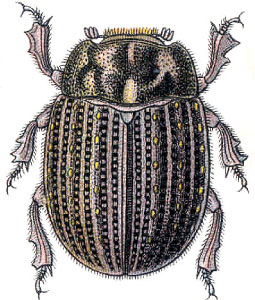
Trogidae, sometimes called hide beetles, is a family of beetles with a distinctive warty or bumpy appearance. Found worldwide, the family includes about 300 species contained in four or five genera.

Dermestidae are a family of Coleoptera that are commonly referred to as skin beetles. Other common names include larder beetle, hide or leather beetles, carpet beetles, and khapra beetles. There are approximately 500 to 700 species worldwide. They can range in size from 1 to 12 mm. Key characteristics for adults are round oval shaped bodies covered in scales or setae. The usually clubbed antennae fit into deep grooves. The hind femora also fit into recesses of the coxa. Larvae are scarabaeiform and also have setae.

Trox is a genus of hide beetle in the subfamily Troginae.

Acanthacaris is a genus of deep-water lobsters. It contains two species, A. caeca and A. tenuimana, and is the only genus in the subfamily Neophoberinae.

Trox scaber is a beetle of the family Trogidae. The 5 to 8 mm long insect is found worldwide, including in Europe, and lives in bird nests.

Acilius sulcatus is a species of water beetle in family Dytiscidae.It is fairly large, with color variation shown throughout its range. Typically it is yellow and black.

Bruchidius siliquastri is a species of bean weevil. It was first found in pods of Cercis siliquastrum in China, and has thence been found in several continents. Its length ranges from 2.8 to 3.7 millimetres. Its body is short and ovate, with a black integument. The apex of its femora and the ventral part of its hind tarsi are reddish. Its vestiture is made of thin and short setae; dorsally setae are a whitish colour, denser on the scutellum. Its pygidium is also covered with setae. Its name is derived from its host plant.
Zaitzevia elongata is a species of riffle beetle which is wingless and flightless. It is found on several of the Ryukyu Islands in Japan in the gravel substrate of streams.
Coelostoma (Holocoelostoma) stultum, is a species of water scavenger beetle widely distributed in Palearctic and Oriental realms from West Pacific towards Indian Ocean, such as China, Taiwan, Andaman Islands, Myanmar, India, Indonesia, Japan, Korea, Malaysia, Mascarene Islands, Nicobar Islands, Oman, Philippines, Saudi Arabia, South Korea, Sri Lanka, Thailand, United Arab Emirates, Oman, and Vietnam.

Coelostoma (Coelostoma) vitalisi, is a species of water scavenger beetle found in China, Taiwan, Japan, India, Indonesia, Japan, Malaysia, Nepal, Singapore, Sri Lanka, Cambodia, Thailand and Vietnam.
Orphinus (Picorphinus) guernei, is a species of skin beetle found in Sri Lanka.
Sphegina (Asiosphegina) atrimanus is a species of hoverfly in the family Syrphidae found in Vietnam.
Sphegina (Asiosphegina) carinata is a species of hoverfly in the family Syrphidae found in Kambaiti Pass, Myanmar, a montane forest with swampy areas and streams located 2000 meters above sea level.
Phoberus is a genus of hide beetle in the subfamily Troginae. It was initially a subgenus of Trox before taxonomists reorganized it into its own genus. The genus is monophyletic, with all species evolved from a single common ancestor. Most beetle species in the genus live in Africa.
Trox confluens is a species of hide beetle in the subfamily Troginae. Within the genus Trox, it is placed in the subgenus Granulitrox. Though this species is disputed, with some taxonomists arguing T. confluens is merely a duplicate of Trox granulipennis, the general consensus is that T. confluens and T. granulipennis are distinct. This beetle lives in Algeria, the Canary Islands, Libya, Morocco, and Tunisia.
Phoberus cyrtus is a species of hide beetle in the subfamily Troginae discovered by Erwin Haaf in 1953.
Phoberus elmariae is a species of hide beetle in the subfamily Troginae discovered by the scientists van de Merwe and Scholtz in 2005. Like with many other beetle species, P. elmariae has not been observed again after its discovery, so all knowledge of the species comes from the 16 individual beetles van de Merwe and Scholtz saw during fieldwork.
Phoberus sternbergi is a species of hide beetle in the subfamily Troginae discovered by the scientists van de Merwe and Scholtz in 2005. Like with many other beetle species, P. sternbergi has not been observed again after its discovery, so all knowledge of the species comes from the 8 individual beetles van de Merwe and Scholtz saw during fieldwork.
Phoberus ngomensis is a species of hide beetle in the subfamily Troginae discovered by the scientists van de Merwe and Scholtz in 2005. Like with many other beetle species, P. ngomensis has not been observed again after its discovery, so all knowledge of the species comes from the 166 individual beetles van de Merwe and Scholtz saw during fieldwork.
Phoberus disjunctus is a species of hide beetle in the subfamily Troginae discovered by coleopterologist Werner P. Strümpher in 2016.







